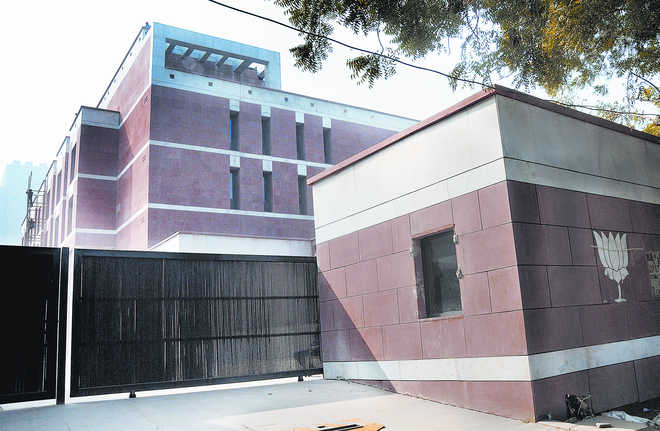Vibha Sharma in New Delhi
Yes, there was a time - nearly four decades ago — the Bharatiya Janata Party did not exist. History indicates the party's pantheon of greats had never really bothered much about a formal venue from where to function. The government bungalow at 11 Ashoka Road — its address for more than 35 years in the heart of Lutyens' Delhi — came into being after the party was reborn in April 1980. Around 66 years ago, its masthead was carried by the Bharatiya Jana Sangh (BJS), which operated from Ajmeri Gate. Today, it looks like life has come full circle for the BJP: it will soon be shifting to its new address in New Delhi, just about a km from where it all began.
The 70-room new office at 6, Deen Dayal Upadhyay Marg (the road named after Jan Sangh's ideologue), is built on two acres and is only 5km from 11, Ashoka Road. The seven-storey plush building is flanked by three-storied complexes and conference rooms. It has a multilevel underground parking that can accommodate more than 150 cars. The building is equipped with new-age features such as a digital library and access-controlled doors and gates — quite different from the white government bungalow at Ashoka Road dotted with jamun trees.
The Ajmeri Gate days
The party's old-timers still remember the Ajmeri Gate days. Vijay Kumar Malhotra, the man credited with keeping the BJP afloat in Delhi for many years along with Madan Lal Khurana and Kedar Nath Sahni, remembers it as if it was yesterday.
"That was the time when we could not afford the rent or settle our tea bills," reminisces the 86-year-old party veteran. Malhotra is among the early associates of the Jana Sangh. He was also the chief executive councilor of Delhi's Metropolitan Council, a post equivalent to that of the chief minister.
Malhotra distinctly remembers when the Jana Sangh moved to one of the two buildings located at Garstin Bastion Road in the early 1950s. Interestingly, the other building on the road was with the Congress.
The GB Road, between Ajmeri Gate and Lahori Gate — is known for one more thing: one of its sections still has a large red-light area with multi-storey brothels and scores of sex workers. Around 1966, the road's name was changed to Swami Shradhanand Marg..
“Along one side (towards Hauz Qazi) was our (Jana Sangh) building, and on the opposite the Congress’,” says Malhotra. Both the buildings were constructed by Khushwant Singh’s father, Daljit Singh.
“In one of rooms Deendayal-ji stayed with Mathur-ji (senior leader Jagdish Prasad Mathur). When Atal Bihari Vajpayee became an MP in 1957 and was allotted 30 Rajendra Prasad Road bungalow, Deendayal-ji shifted there. My marriage ceremony also took place at his residence. I was then a corporation member,” recalls Malhotra.
Tumultuous days
The Congress split following the expulsion of Indira Gandhi in 1969. The Indian National Congress (Organisation) then formally merged with the Bharatiya Lok Dal, the Jana Sangh, the Socialist Party of India, the Swatantra Party and others to form the Janata Party.
Later, when it shifted operations to the Vithal Bhai Patel House, the Ajmeri Gate office was passed on to the Bharatiya Mazdoor Sangh, an affiliate of the Rashtriya Swayamsewak Sangh, the BJP's ideological fountainhead. After Janata Party split, the Jana Sangh came together to re-form as the BJP.
Before it shifted to 11 Ashoka Road, it also functioned for some time from 10, Rajendra Prasad Marg, a house allocated to Nanaji Deshmukh. The 11, Ashoka Road, the BJP's current address, was originally allotted to Sunder Singh Bhandari, a Rajya Sabha member.
Soon after shifting, the party was reduced to two seats in the 1984 Lok Sabha polls. Yet it was from here that the party evolved to its current status as an “election-winning machine”. It was from here that it first tasted success at the Centre, even if it was for 13 days, in 1996. It was from here that it returned to power in 1998 and again in 1999 as the NDA.
Expansion begins
Apart from some minor changes and additions of rooms in the back lawns for functionaries and a conference hall for media interactions and party' meetings, 11 Ashoka Road remained unchanged until Nitin Gadkari became the president. It was during his stewardship that the Type-VIII bungalow was re-modeled with an auditorium, a building with a conference hall and rooms for the party president and office-bearers. Many rooms were added to increase space and facilities for the growing party which went on to form the government at the Centre in 2014 and subsequently in several states.
It is here that the party’s future strategies are drawn by Shah and victories are celebrated with Prime Minister Narendra Modi.
Leaders say the party would return the bungalow to the CPWD when it shifts to the new address. Political parties have been allotted land to shift from the sensitive Lutyens' zone where political activities often lead to traffic nightmares.
Unlock Exclusive Insights with The Tribune Premium
Take your experience further with Premium access.
Thought-provoking Opinions, Expert Analysis, In-depth Insights and other Member Only Benefits
Already a Member? Sign In Now










